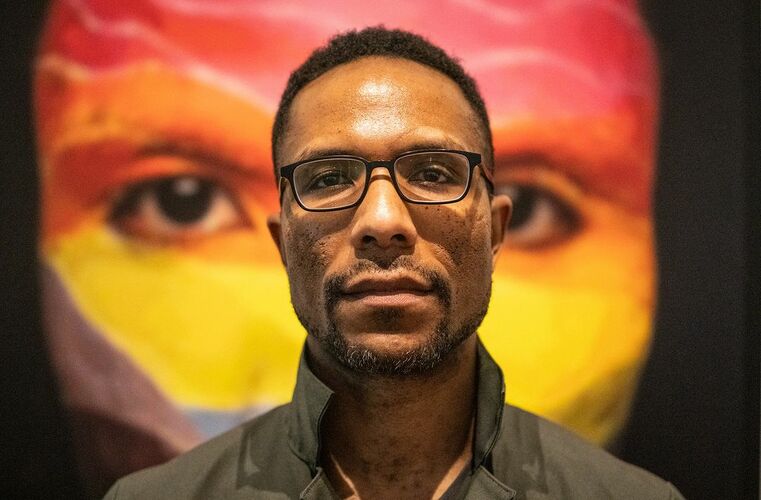BRATTLEBORO — A Boston-based multimedia artist, filmmaker, and graphic designer will lead a hands-on workshop that will dive into participants' inner reflections and new internal discoveries.
Daniel Callahan, whose exhibit “Daniel Callahan: En-MassQ” is on display at the Brattleboro Museum & Art Center through Sunday, June 11, will share his work in MassQing, a form of decoration of the body that uses the face as a canvas for line, shape, and color to express what is inside.
“We often think of a mask as something we use to hide our identity or something we hide behind, or even something to protect us,” said Callahan. “But these masks are used to reveal and to bring what's inside out.”
As described on his website, “In virtually all indigenous cultures, art is regarded not as objects in isolation, but as instruments for ritual - used to align, balance and relate the mundane with the mystical, the known with the unknown, and the 'us' with the 'other' in order to bring about meaning, order, and harmony to all.”
Callahan says that in his practice, he uses ritual “as a method, a way in which to approach not only my art, but my life. Through it I look to become a fuller human being and to create work that is deeply informed by, but ultimately transcendent of, time, culture, and geography.”
The ritual face-painting workshop is very much based on indigenous practices of body decoration. “We started to realize how strong of a connection many different people have, culturally to that art form,” he said.
“The idea is that each MassQ is supposed to represent sort of where you are at the moment. So when I'm asking myself, it's very much about a sort of introspection and reflection.” Callahan said.
He explained that when he is MassQing other people, he has ended up talking with them for a while and has gotten to know who and where they are in that moment.
“I also just look,” he said. “And then looking at someone's face for over a long period of time as they talk, I just start to see shapes and colors and lines.”
Callahan said he doesn't just see one specific thing so much as he sees an essence.
“That essence is really a reflection of that person but also my perception of that person and also our connection in the moment that the MassQ is created,” he said.
Callahan never uses the same mask twice: “Each mask is supposed to represent where you are in the moment. And we're constantly changing and evolving,” he said.
“Even if you're just looking at the work from sort of a detached point of view, you still have to engage with another human being to see the work,” he pointed out. “You literally have to look into someone's eyes.”
The artist behind the mask
Callahan said his father inspired him to pursue art. He explained how his father would draw whatever he loved at the moment.
“That always fascinated me, in terms of his ability to take an idea in his mind and then translate it onto a page and have that be like a permanent or the semi-permanent kind of thing that would hang on my wall,” he said.
Callahan earned a bachelor's degree in fine arts and Africana studies from the University of Philadelphia in 2007 and, with a full fellowship, a MFA from Emerson College in 2017.
His work has been featured at the Museum of Fine Arts, Isabella Stewart Gardner Museum, Institute of Contemporary Art, New Orleans Museum of Art, and Queens Museum, as well as in publications such as The Believer, The Bay State Banner, and Global Journal of Hip-Hop Culture.
Threaded through a multidisciplinary career in teaching and commercial art are a number of multimedia projects centered on MassQing.
Callahan said he has done MassQing workshops a number of times, many with a younger audience, usually teenagers.
“I think it's like the perfect age group, because they're changing so much. And they're trying to find out who they are,” he said. “And they're looking to connect in a way that makes them really open and act and [be] sort of willing to engage in such a practice.”
The self-exploration journey continues
Callahan said he usually has people MassQ themselves first, and then, if there is more time, they can MassQ one another. “Now that you've learned how to be introspective and reflective and listen to yourself at that, apply that to somebody else's story and see if you can do that with someone else.”
He observed that some people come to the workshop groups uninterested in participating, “but by the end of the workshop, they're doing it.”
He said then they become fully invested and they get a lot out of the workshop, where “somebody changed how they even behave, or how they're what they're willing to open up to and hearing people's stories.”
“You learn new things about people through MassQing that you didn't know before because of people sharing themselves,” Callahan said. “Those are sort of my favorite memories from masking workshops.”
